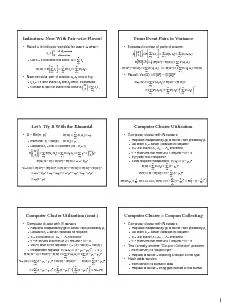

1 wise Flavor Recall I i is indicator variable for event A i when Let X of events that occur Now consider pair of events A i A j occurring I i I j 1 if both events A i a ID: 832056
Download Pdf The PPT/PDF document "Indicators: Now With Pair" is the property of its rightful owner. Permission is granted to download and print the materials on this web site for personal, non-commercial use only, and to display it on your personal computer provided you do not modify the materials and that you retain all copyright notices contained in the materials. By downloading content from our website, you accept the terms of this agreement.
1Indicators: Now With Pair-wise Flavo
1Indicators: Now With Pair-wise Flavor!â¢Recall Iiis indicator variable for event Aiwhen:ï§Let X = # of events that occur:â¢Now consider pair of events AiAjoccurringï§IiIj= 1 if both events Aiand Ajoccur, 0 otherwiseï§Number of pairs of events that occur is From Event Pairs to Varianceâ¢Expected number of pairs of events:â¢Recall: Var(X) = E[X2] â(E[X])2Letâs Try It With the Binomialâ¢X ~ Bin(n, p)ï§Each trial: Xi~ Ber(p)ï§Let event Ai= trial iis success (i.e., Xi= 1)Computer Cluster Utilizationâ¢Computer cluster with N serversï§Requests independently go to server iwith probability piï§Let event Ai= server ireceives no requestsï§X = # of events A1, A2, ïª Anthat occurï§Y ï½ # servers that receive ⥠1 request ï½ N âXï§E[Y] after first nrequests?ï§Since requests independent:Computer Cluster Utilization (cont.)â¢Computer cluster with N serversï§Requests independently go to server iwith probability piï§Let event Ai= server ireceives no requestsï§X = # of events A1, A2, ïª Anthat occurï§Y ï½ # servers that receive ⥠1 request ï½ N âXï§Var(Y) after first nrequests?ï§Independent requests:( = (-1)2 Var(X) = Var(X) )Computer Cluster = Coupon Collectingâ¢Computer cluster with N serversï§Requests independently go to server iwith probability piï§Let event Ai= server ireceives no requestsï§X = # of events A1, A2, ïª Anthat occurï§Y ï½ # servers that receive ⥠1 request ï½ N âXâ¢This is really another ï²Coup
on Collectorâ problemï§Each server
on Collectorâ problemï§Each server is a ï²coupon typeâï§Request to server = collecting a coupon of that typeâ¢Hash table versionï§Each server is a bucket in tableï§Request to server = string gets hashed to that bucket2Product of Expectationsâ¢Let X and Y are independent random variables, and g(ï·) and h(ï·) are real-valued functionsï§Proof:The Dance of the Covarianceâ¢Say X and Y are arbitrary random variablesâ¢Covariance of X and Y:â¢Equivalently:ï§X and Y independent, E[XY] = E[X]E[Y] ï Cov(X,Y) = 0ï§But Cov(X,Y) = 0 does notimply X and Y independent!Dependence and Covarianceâ¢X and Y are random variables with PMF:ï§E[X] = 0, E[Y] = 1/3ï§Since XY = 0, E[XY] = 0ï§Cov(X, Y) = E[XY] âE[X]E[Y] = 0 â0 = 0â¢But, X and Y are clearly dependentXY-101pY(y)01/301/32/3101/301/3pX(x)1/31/31/31Example of Covarianceâ¢Consider rolling a 6-sided dieï§Let indicator variable X = 1 if roll is 1, 2, 3, or 4ï§Let indicator variable Y = 1 if roll is 3, 4, 5, or 6â¢What is Cov(X, Y)?ï§E[X] = 2/3 and E[Y] = 2/3ï§E[XY]== (0 * 0) + (0 * 1/3) + (0 * 1/3) + (1 * 1/3) = 1/3ï§Cov(X, Y) = E[XY] âE[X]E[Y] = 1/3 â4/9 = -1/9ï§Consider: P(X = 1) = 2/3 and P(X = 1 | Y = 1) = 1/2oObserving Y = 1 makes X = 1 lesslikelyAnother Example of Covarianceâ¢Consider the following data:WeightHeightWeight * Height645736487159418953492597676241545551280558502900775542355748273656422352514221427661463668573876E[W] = 62.75E[H] = 52.75E[W*
H]= 3355.83303540455055606540
H]= 3355.833035404550556065404550556065707580HeightWeightCov(W, H) = E[W*H] âE[W]E[H]= 3355.83 â(62.75)(52.75)= 45.77Properties of Covarianceâ¢Say X and Y are arbitrary random variablesï§ï§ï§â¢Covariance of sums of random variablesï§X1, X2, ïª, Xnand Y1, Y2, ïª, Ymare random variablesï§3Variance of Sum of Variablesâ¢ï§Proof:ï§If all Xiand Xjindependent (i ï¹j): Note:By symmetry:Hola Compadre: La Distribución Binomialâ¢Let Y ~ Bin(n, p)ï§nindependent trialsï§Let Xi= 1 if i-th trial is ï²successâ, 0 otherwiseï§Xi~ Ber(p)E[Xi] = pï§Var(Y) = Var(X1) + Var(X2) + ... + Var(Xn)ï§Var(Xi)= E[Xi2] â(E[Xi])2= E[Xi] â(E[Xi])2since Xi2= Xi= p âp2= p(1 âp)ï§Var(Y) = nVar(Xi) = np(1 âp)Variance of Sample Meanâ¢Consider nI.I.D. random variables X1, X2, ... Xnï§Xi have distribution Fwith E[Xi] = mand Var(Xi) = s2ï§We call sequence of Xia samplefrom distribution Fï§Recall sample mean: whereï§What is ?Sample Varianceâ¢Consider nI.I.D. random variables X1, X2, ... Xnï§Xi have distribution Fwith E[Xi] = mand Var(Xi) = s2ï§We call sequence of Xia samplefrom distribution Fï§Recall sample mean: whereï§Sample deviation: for i = 1, 2, ..., nï§Sample variance:ï§What is E[S2]?ï§E[S2] = s2ï§We say S2is ï²unbiased estimateâ of s2Proof that E[S2] =s2(just for reference)ï§So, E[S2] = s